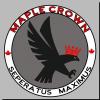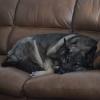Sukhoi Su-7A "Fitter-A" - Fighter Regiment No.923, Vietnamese People's Air Force, 1965
During the summer of 1953 the newly re-opened Sukhoi OKB began work on a new swept-wing jet fighter. The first prototype, designated S-1, featured a boldly swept-wing of 60° sweep with hydraulically boosted controls and powered by the new Lyulka AL-7 single-spool turbojet fed via a nose intake equipped with a movable inlet cone for managing airflow to the engine at supersonic speeds. First flown on September 7th, 1955 with A. G. Kochetkov at the controls the prototype soon established a Soviet speed record of 1,350 mph (Mach 2.05) in April 1956. The second prototype, designated S-2, introduced some aerodynamic refinements but testing was delayed by an unreliable engine and the unfortunate loss of the S-1 in a crash killing it's pilot I. N. Sokolov in November 1956. Despite this, the first production version (by now designated Su-7A) entered service with the Soviet Air Force in 1958 as a tactical fighter for Frontal Aviation and continued in low-rate production until 1960 with just 132 aircraft built and seeing limited operational use in the Far East from 1958 before being retired in 1965.
Meanwhile, the Vietnamese People's Air Force received its first jet fighter aircraft in early 1964 when Fighter Regiment No. 921 was formed flying MiG-17's and they were soon followed by Fighter Regiment No.922 also flying MiG-17's. By the end of 1964, the Vietnamese People's Air Force joined the supersonic club when Fighter Regiment No.923 (led by Lt. Col. Nguyen Phuc Trach) was formed flying Su-7A's transferred from the Soviet Air Force via mainland China and flown by North Vietnamese pilots trained by Chinese advisors. On April 4th, 1965, Su-7A's of the Vietnamese People's Air Force downed two American F-105 Thunderchief's attacking the Thanh Hóa Bridge in a high speed GCI controlled 'hit and run' intercept against a large American air strike group. However, despite this early success, the Su-7A was completely outclassed by American fighters and the dwindling Su-7A force was eventually grounded and re-equipped with the Shenyang J-6 (Chinese-built MiG-19).



















